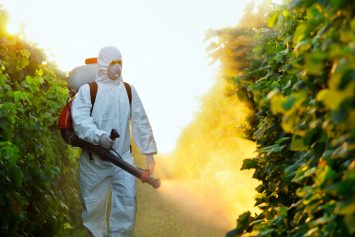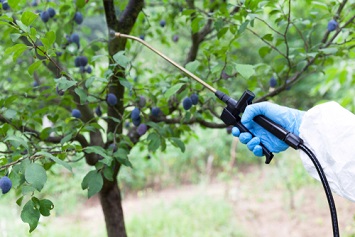Senator Tom Udall (D-NM) and U.S. Representative Joe Neguse (D-Colo.) introduced the Protect America’s Children from Toxic Pesticides Act of 2020 (PACTPA) bill into Congress on August 4, 2020. The purpose of the bill, if passed, is to protect consumers, farmworkers, and children from harmful pesticides.
It marks the first attempt to update laws related to pesticide control since 1996.
“Families across the country fill their shopping carts with food every day to feed their families, trusting that American produce and grains are safe to eat. But in many cases, our food is sprayed with pesticides considered highly toxic or dangerous. Our nation’s pesticide laws have not kept up to keep us safe,” Udall said. “The United States sprays a total of over a billion pounds of pesticides each year on the food we feed to our children, exposing them to dangerous chemicals linked to brain damage and diseases like Parkinson’s.”
Frontline runoff from pesticides also harms water supplies and has potential pollution impacts, Udall said. “And the pollinator communities—bees, butterflies, and other insects—that we depend on to grow our food are collapsing from poisonous insecticide … science is warning us that we must protect critical links in our food chain and protect children and farmworkers from brain damage and other health risks of dangerous pesticides.”
If passed, the bill would ban three categories of insecticides and herbicides: organophosphate insecticides, which have been linked to neurological damage; neonicotinoid insecticides, which have been linked to harming pollinators, like bees; and paraquat herbicides, which have been linked to Parkinson’s disease.
The bill would create a faster review process by the EPA for chemicals considered unsafe by the European Union. The current regulations for registering pesticides grants the EPA leeway to “allow exemptions for pesticide uses without a thorough regulatory review,” according to timesrepublican.com.
EPA Pesticide Review Process
With a time frame of 10–12 years and a $300 million price tag, bringing a new pesticide to market is a costly process, according to Farm Journal’s AgPro.
After the initial registration, pesticides must provide updated data and reregister approximately every 15 years.
The EPA’s registration review process involves:
- The docket opening where a public document is created with a summary of available information about the pesticide and the anticipated plan for approval, which includes “facts about the pesticide’s current use and usage, anticipated risk assessment and data needs and an estimated timeline for review,” according to AgPro. The EPA provides public comment periods for a minimum of 60 days after publication.
- The next step is conducting “focus meetings,” during which registrants and others address missing studies, unclear labels, or other areas of uncertainty. These meetings are available to the public.
- The third step is the case development phase, which is when the Agency reviews the available data, including changes in data since the last review if the pesticide was previously registered. New assessments are conducted, as necessary. A draft risk assessment is published, which includes a public comment period, and regulatory partners such as the National Marine Fisheries Service and the U.S. Fish and Wildlife Service are consulted.
- The final step is the registration review decision, when an Agency determination is made regarding whether the pesticide meets the registration standard and issues a proposed decision. This decision provides for a 60-day comment period. The comments are considered, and the Agency’s final registration decision is published to the Federal Register.
Types of Federal Insecticide, Fungicide, and Rodenticide Act (FIFRA) registrations
- Registration: Section 3 of FIFRA allows the EPA to register pesticides for use throughout the United States.
- Experimental Use Permits (EUPs): Section 5 of FIFRA allows the EPA to grant EUPs for manufacturers to field-test pesticides under development. Manufacturers are required to obtain experimental use permits before “testing new pesticides or new uses of pesticides if they conduct experimental field tests on 10 acres or more of land or one acre or more of water.”
- Emergency Exemptions: Section 18 of FIFRA grants the EPA power to allow state and federal agencies to permit the unregistered use of a pesticide in a specific geographic area for a limited time if emergency pest conditions exist. Exemptions may also be approved for public health and quarantine reasons.
- State-Specific Registrations: Section 24(c) of FIFRA provides states with jurisdiction to register a new pesticide product for any use, or a federally registered product for an additional use, as long as there is both a demonstrated “special local need” and a tolerance, an exemption from a tolerance, or other clearance under the Federal Food, Drug, and Cosmetic Act (FFDCA). Although, the EPA has the authority to disapprove a state’s special local need registration application.
Pesticide Use Exemptions
“Minimum risk pesticides” are exempt from FIFRA registration. These pesticides must meet six conditions, according to the EPA:
- “Condition 1: The product’s active ingredients must only be those that are listed in 40 CFR 152.25(f)(1).”
- “Condition 2: The product’s inert ingredients may only be those that have been classified by EPA as:
- Listed in 40 CFR 152.25(f)(2)
- Commonly consumed food commodities, animal feed items, and edible fats and oils as described in 40 CFR 180.950(a), (b), and (c); and
- Certain chemical substances listed under 40 CFR 180.950(e).”
- “Condition 3: All of the ingredients (both active and inert) must be listed on the label. The active ingredient(s) must be listed by label display name and percentage by weight. Each inert ingredient must be listed by label display name.”
- “Condition 4: The product must not bear claims either to control or mitigate organisms that pose a threat to human health, or insects or rodents carrying specific diseases.”
- “Condition 5: The name of the producer or the company for whom the product was produced, and the company’s contact information must be displayed prominently on the product label.”
- “Condition 6: The label cannot include any false or misleading statements.”
PACTPA Specifics
In addition to banning certain pesticides, the bill also proposes:
- “Creating a petition process to enable individual citizens to petition the EPA to identify dangerous pesticides so that the EPA would no longer be able to indefinitely allow dangerous pesticides to remain on the market”;
- “Closing dangerous loopholes that have allowed the EPA to issue emergency exemptions and conditional registrations to use pesticides before they have gone through full health and safety review by the agency”;
- “Enabling local communities to enact protective legislation and other policies without being vetoed or preempted by state law”;
- “Requiring employers of farmworkers to report all pesticide-caused injuries to the EPA, with strong penalties for failure to report injuries or retaliating against workers”;
- “Directing the EPA to review pesticide injury reports and work with the pesticide manufacturers to develop better labeling to prevent future injury”; and
- “Requiring that all pesticide label instructions be written in Spanish and in any language spoken by more than 500 pesticide applicators.”
Industry Viewpoint
Opponents of the bill include many farmers who claim health risks are often exaggerated. They believe the regulations proposed by the bill would make their work too challenging, according to timesrepublican.com.
“It’s not a broken thing that needs fixing,” said Zach Riley, the director of public policy and national affairs at the Colorado Farm Bureau.
The pesticides proposed to be banned by the bill are safe when used properly by trained workers, and limiting the use of these pesticides will add unnecessary costs to food production, he said.
“You’re taking away a necessary tool that makes things affordable and easy to accomplish this goal of growing food,” Riley said. “When you take away a tool from somebody’s toolbox, it makes things much more costly and difficult.… If you’re losing crops to either insect infestation or weeds or anything like that, you’re losing money.”
Neonicotinoids
Neonicotinoids (neonics) are one of the pesticides the bill seeks to ban. The use of neonicotinoid insecticides in U.S. agricultural production has grown dramatically in the past decade, according to the National Center for Biotechnology Information (NCBI). “Currently more than 90% of all corn and 44–50% of soybeans are grown from seeds coated with neonics, and they are used extensively on other cereal and oil crops and fruit and vegetables as well,” according to the NCBI. “[Neonics] are also applied later in the growing cycle via drip and broadcast and foliar spraying. In the United States, it is estimated that more than 4 million pounds of neonics are applied to between 140 and 200 million acres of cropland annually. The value of neonic treated seeds alone is worth approximately $1.4 billion to the U.S. economy.”
Neonics target all insects, including good insects like bees and predators of the insects that destroy crops, said Beth Conrey, a Berthoud-based beekeeper and co-chair of the People and Pollinators Action Network, a Colorado group that advocates for pollinator habitat protections and against pesticide use.
“Somewhere along the line, we decided that most bugs are bad, and that is absolutely false,” Conrey said. “Most bugs are beneficial and in a lot of senses we have created more bad bugs with our treatment methodologies.”
City Perspective
Boulder, Colorado, approved 67 state and federal policy goals, including the ability to locally regulate pesticide use, in March. Changes proposed in the PACTPA bill would include allowing cities to set higher standards for the regulation of pesticide use than permitted by state and federal policies.
“Boulder’s going to want to go a lot farther than other local governments,” said Hannah Collazo, state director of Environment Colorado, an environmental advocacy group. “But right now, they don’t even have the power to regulate pesticides.”
All pollinators face threats from a number of sources, including “increased disease and mite parasites, lack of genetic diversity, habitat loss due to the expansion of urban landscapes and crop monoculture, stress due to the transport of commercial hives to California to pollinate almonds and environmental toxins including pesticides,” according to the Colorado Department of Agriculture.
Seventy-five percent of food grown in the United States is pollinated by insects, Collazo said. It is important to protect these pollinators.
Starting Point
The PACTPA bill is only a starting point, and supporters expect it to change and evolve before it becomes law.
The bill is expected to become a useful tool “to educate members of Congress and advocacy groups about the shortcomings of the current system,” according to Udall.
Advocating for stronger pesticide regulations is a necessary reform in the United States, Neguse said.
“Us putting a stake in the ground in terms of what reform looks like in this sphere in my view is a positive step,” Neguse said at the news conference about the bill. “Our hope is we can build on that, if not (this year), then we’ll certainly carry the baton into the (next) Congress.”
The bill faces serious opposition from the Colorado Farm Bureau and is not likely to become law anytime soon, but supporters believe it provides an important first step to eventually change federal law, according to timesrepublican.com.


